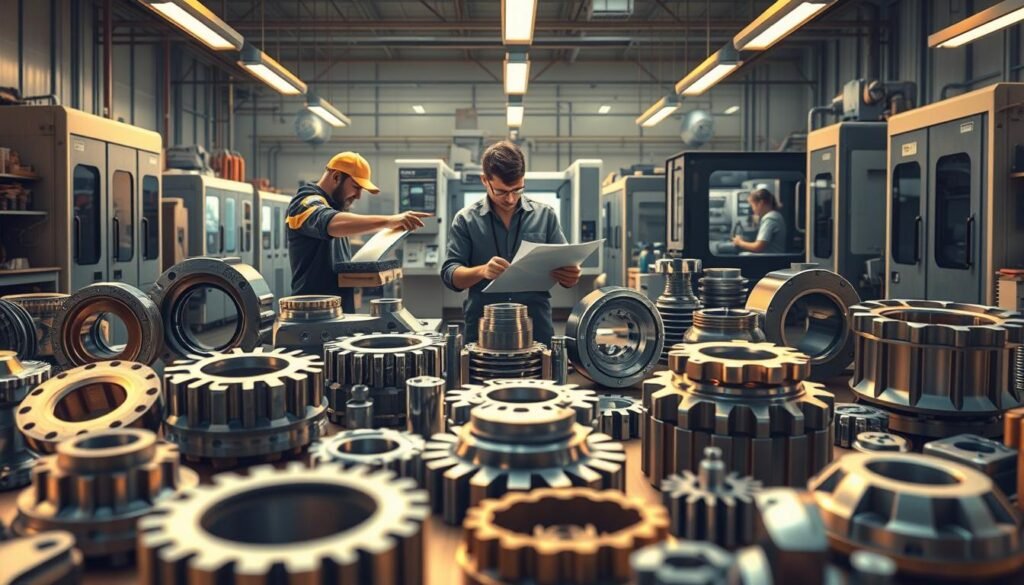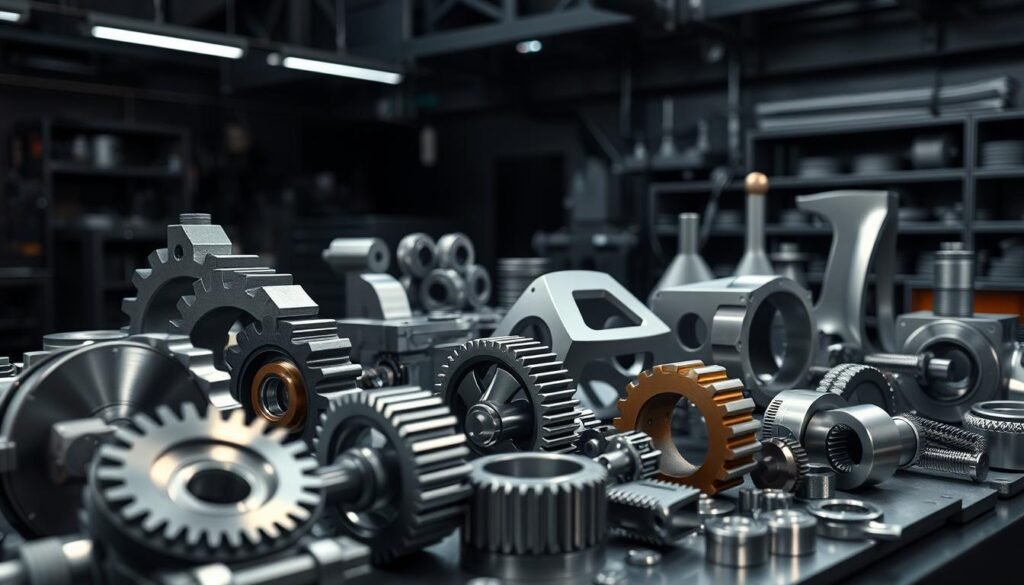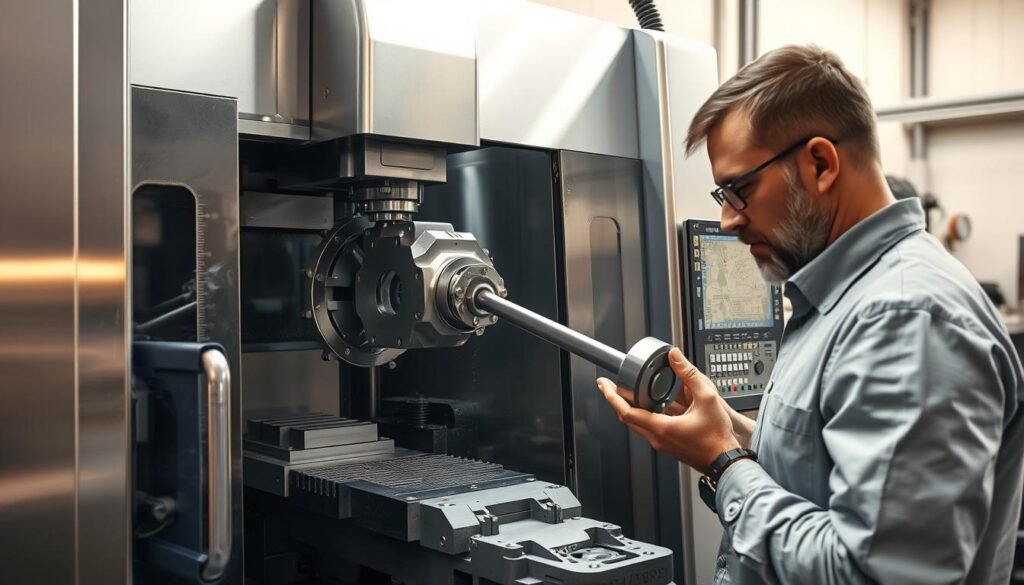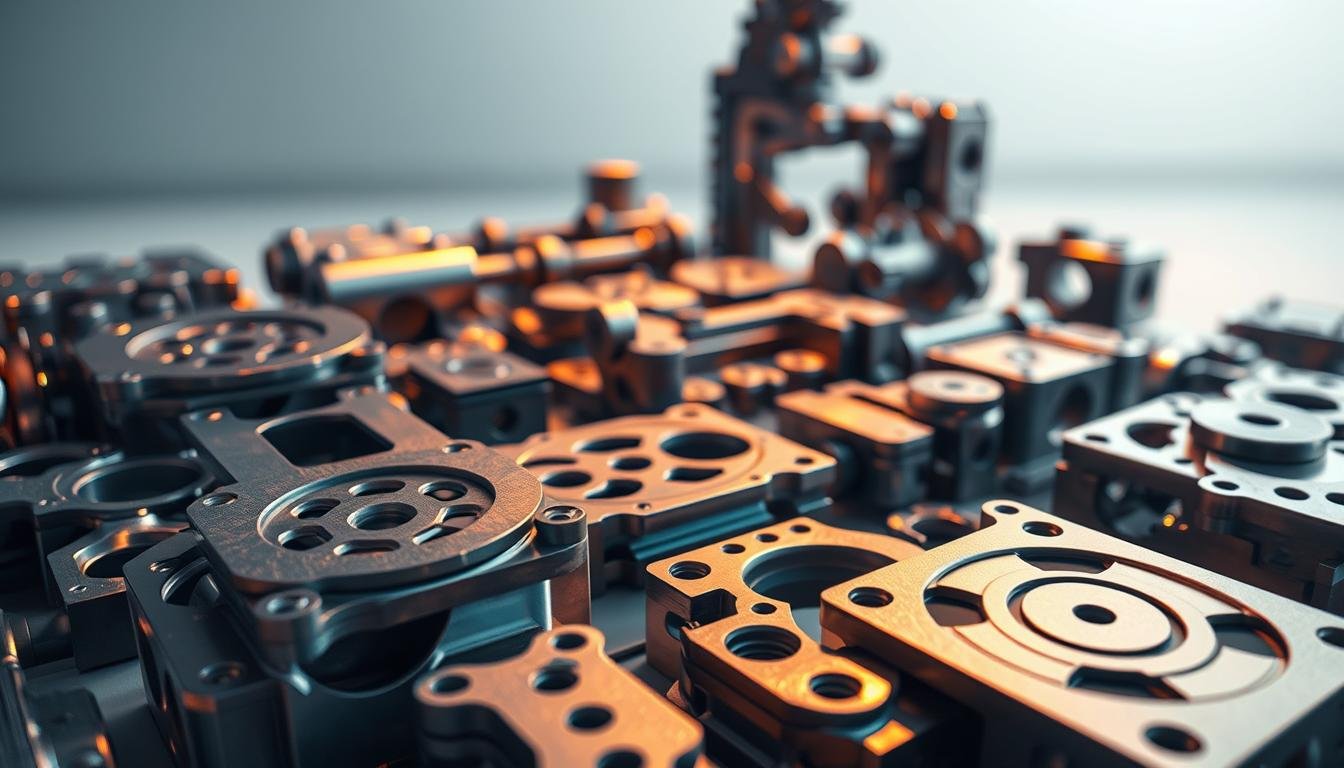In today’s world, Custom CNC Components are more needed than ever. They are key for meeting special design needs in many fields. We use CNC manufacturing to make sure our parts are top-notch and reliable.
We focus on making solutions that fit exactly what our customers need. This helps them work better and more efficiently. Our goal is to make sure our custom CNC parts make our customers happy.
Key Takeaways
- Custom CNC Components are essential for unique design requirements.
- High-quality CNC machining ensures precision in production.
- CNC manufacturing processes enhance operational efficiency.
- Tailored solutions cater to diverse industry needs.
- Reliability and quality are paramount in custom component delivery.
Understanding the CNC Machining Process
The CNC machining process uses computer-controlled machines to cut out parts from solid blocks. It makes precise components for many industries. Precision machining services are key for exact sizes and tolerances needed today.
What is CNC Machining?
CNC machining is an automated process that uses computer guidance. It turns CAD models into G-code for smooth production. This method works with many materials like metals and plastics, making it versatile.
Key Steps in the CNC Manufacturing Process
- Quoting: Initial discussions on project requirements and cost estimation.
- Material Sourcing: Choosing the right material based on design specs.
- Machine Programming: Converting design files into machine-readable code.
- Machining Process: Doing the CNC machining with precision.
Knowing each step helps make production smoother and better. The whole process is key to high standards in precision machining services.
Importance of Precision in CNC Machining
Precision is very important in CNC manufacturing, where tight tolerances are needed. This is true for industries like aerospace and defense. High accuracy means better performance and reliability of parts.
This focus on precision helps in making prototypes and mass production. It’s a crucial technology in today’s manufacturing world. For more on CNC machining and precision, check out this resource.
Capabilities of Custom CNC Components
Custom CNC components are very versatile. They can be made into unique parts for specific needs. This makes products better and more functional.
Flexibility in Designing Unique Parts
Specialized CNC parts are very adaptable. They can handle designs that other methods can’t. Some benefits include:
- Creating complex shapes with great precision.
- Customizing parts to fit exact needs.
- Making production faster, which cuts down on wait times.
Material Variety for Custom Designs
Custom CNC components come in many materials. You can pick from metals, plastics, and composites. This ensures each part meets high standards. The benefits are:
| Material Type | Properties | Common Applications |
|---|---|---|
| Aluminum | Lightweight, corrosion-resistant | Aerospace, automotive |
| Stainless Steel | Strength, durability | Medical devices, equipment |
| Plastics | Versatile, cost-effective | Consumer products, electronics |
| Composites | High strength-to-weight ratio | Sports equipment, aerospace |
Factors Driving the Need for Custom CNC Components

The need for custom CNC components is growing fast. This is because designs are getting more complex. People need parts that are precise and have new designs that old methods can’t make.
Complex Design Requirements
Precision is key in custom CNC machining. Companies face tough challenges that need advanced engineering. They want parts that are unique and high-quality.
Fields like aerospace and cars need these special parts. They want parts that work well and are reliable.
Industry-Specific Applications
Every industry has its own needs for custom CNC parts. In medicine, these parts make devices work better. In tech and defense, they help companies stay ahead.
These industry-specific applications show why custom parts are needed. They meet the unique needs of each field.
Advantages Over Traditional Manufacturing Methods
Custom CNC machining has big benefits over old ways. It’s faster, which means companies can meet demands quickly. It also saves money by using less material and cutting down on waste.
It’s also very precise. This means every part is top-notch. These advantages make custom parts more popular in many industries.
Precision Machining Services for High-Quality Outputs

Precision machining services are key in making parts that meet strict standards. We use advanced tech and methods. This ensures every part is accurate for use in many industries.
Types of Precision Machining Services
We offer many precision machining services, including:
- CNC Milling: This method makes complex shapes and high tolerances, key for modern designs.
- CNC Turning: Great for cylindrical parts, it’s fast and precise.
- Laser Cutting: It gives clean edges and can cut detailed designs with high accuracy.
Ensuring Dimensional Accuracy
To get top-notch CNC machining, focusing on dimensional accuracy is key. We use the latest software to watch and adjust the process live. With strict quality checks, we make sure our parts are not just up to but exceed standards.
Our commitment to precision machining shows in every part we make. This makes us a reliable partner in the manufacturing world.
Utilizing Specialized CNC Parts for Enhanced Functionality

Specialized CNC parts are made for unique needs in many industries. They are designed to fit perfectly, improving how things work. This makes machines work better and saves time.
Custom Fits and Functions
Every project is different, so custom fits are key. CNC parts can be made just right for each client. They can change shape, material, and size to fit perfectly.
This makes parts work better in their systems. Here are some examples:
- Precision fittings for medical devices
- Custom gears for cars
- Special tools for space projects
Case Studies of Specialized CNC Parts in Action
Looking at real examples shows how CNC parts work. One company made custom gears for their machines. This made their machines last longer and cost less to fix.
Another company in space needed parts that were light but strong. They used CNC parts to save weight and keep things strong. These stories show we make parts that solve real problems.
Custom CNC Fabrication Processes

Understanding custom CNC fabrication is key for top-notch results. It’s all about using the right techniques for precision. By making smart design choices, companies can use CNC machining to their advantage.
Overview of Fabrication Techniques
Custom CNC fabrication uses many techniques like milling, drilling, and routing. Each has its own benefits for different projects. These methods help make parts that meet high standards, ensuring quality and reliability.
For more on CNC machining, check out this resource.
Design-for-Manufacturing (DFM) Best Practices
Designing for manufacturing is crucial for efficient CNC fabrication. Designers and engineers working together leads to cost savings and faster production. They simplify designs and standardize parts to boost efficiency.
Following these guidelines improves manufacturability and speeds up making custom parts. Sticking to these practices helps manufacturers stay ahead in the market. Learn more about CNC turning services here.
Optimizing Designs for CNC Manufacturing
When we start optimizing CNC designs, it’s key to know the limits of CNC machining. These limits affect how easy and cheap it is to make a product. By working within these limits, we can make designs that work well and are affordable.
Adhering to Design Limitations
Design limits are very important in CNC making. Things like how tools can reach, how thick materials are, and what shapes can be made matter a lot. Knowing these helps designers:
- Make sure parts can be made easily without needing to change tools a lot.
- Lower the chance of mistakes by knowing what CNC machines can do.
- Design parts so they fit together well.
Best Practices for Cost-Effective Designs
Creating designs that save money is more than just picking cheaper materials. It’s about a whole plan that includes:
- Picking materials that are good for the price and quality.
- Designing shapes that use less material but are strong.
- Using common parts to cut down on machining time.
By using these tips, we can make our CNC designs better. This leads to more efficient and cheaper production.
Understanding CNC Prototyping
CNC prototyping is key in checking designs before making them real. It makes designs more accurate and boosts confidence in the product. This way, teams can make changes quickly and meet project goals.
Role of Prototyping in Design Validation
Design validation through CNC prototyping is very important. It shows how a product works in real life. It finds problems early, saving money later.
Good prototyping makes sure designs meet all needs and expectations.
Benefits of Rapid Prototyping
Rapid prototyping is fast and saves money. CNC prototyping can make prototypes in 1-3 days. This helps businesses meet market needs fast.
- Increased design flexibility: Try out different models.
- Enhanced troubleshooting: Find and fix problems early.
- High precision: Prototypes are made with exact details, ensuring quality.
For more on fast and reliable options, check out CNC prototyping services. It shows how to use advanced tech to improve product making.
Collaboration in the Custom Machine Shop Environment
In custom machine shops, teamwork is key to making top-notch parts. Designers and machinists working together is crucial for success. They need to talk clearly, share ideas, and make sure designs work well.
Communication Between Designers and Machinists
Good communication between designers and machinists is essential. When they share their thoughts and plans, mistakes go down. This leads to smoother work.
Important ways to talk include:
- Regular meetings to discuss project phases and updates
- Creation of detailed design documents and specifications
- Use of visual aids and prototypes to communicate complex ideas
This teamwork helps everyone understand the design better. This leads to parts that meet or beat what clients want.
The Importance of Feedback and Iteration
The design process that keeps improving is vital. Getting feedback at each step helps make small changes. This is important for:
- Improving how parts work through small tweaks
- Finding and fixing design problems early
- Working better together as everyone helps solve problems
By using the design process that keeps getting better and staying open to feedback, the results show the skill of everyone involved. It also shows the power of working together.
Inspection and Quality Control in CNC Manufacturing
In CNC manufacturing, keeping high standards is key. We use top-notch tools and human skills to make sure parts are perfect. This way, we deliver parts that are precise and meet all the specs.
Tools and Techniques for Quality Assurance
Advanced technology is a big part of our quality check. We use:
- Micrometers: These are vital for measuring tiny sizes with great accuracy.
- Coordinate Measuring Machines (CMMs): They give us exact 3D measurements of parts.
- Gauges: These help us quickly check if parts are the right size.
These tools help us find problems early. This saves time and makes sure our products are top-notch.
Role of Human Oversight in the CNC Process
Technology is important, but human eyes are even more so. Our skilled team watches over the CNC machines. They make sure everything runs right and catches any problems fast.
This mix of tech and human insight makes us very reliable. We produce parts that are of the highest quality.
Conclusion
Our look into custom CNC components shows their big role in today’s making world. CNC machining is key; it lets companies make precise, complex parts. This meets specific needs with high quality.
We talked about teamwork, checking, and quality control in CNC making. These steps lead to great results. Looking ahead, we’re ready to use new ideas and keep up with industry changes.
We aim to be top in making custom CNC parts. We want to go beyond what our customers expect. We’re excited for the new things coming in this fast-changing field.
FAQ
What are Custom CNC Components and why are they important?
Custom CNC Components are made to fit specific needs in many fields. They ensure parts are precise, high-quality, and work well in complex tasks. This helps makers reach their goals.
How does the CNC machining process work?
CNC machining removes material from a block based on a plan. It starts with a quote, then finding the right material. Next, the machine is programmed with G-code from CAD models. The final step is machining.
What types of materials can be used in CNC machining?
CNC machining works with metals, plastics, and composites. This lets makers create parts that meet exact needs and performance.
What are the advantages of custom CNC components over traditional manufacturing methods?
Custom CNC parts have many benefits. They are faster, cheaper, and more precise than old methods. They also handle complex designs better.
What precision machining services do you offer?
We provide CNC milling, turning, and laser cutting. These services aim for top-quality parts that meet strict standards.
How do you ensure dimensional accuracy in your CNC machining?
We use advanced software and quality checks like CMMs. This ensures parts meet exact specs and high precision.
How do specialized CNC parts enhance functionality?
Special CNC parts are made for specific tasks in different fields. They solve unique problems and boost efficiency. Real examples show how they improve performance.
What fabrication techniques are integral to custom CNC machining?
Key techniques include milling, drilling, and routing. These are crucial for making custom parts that meet client needs.
What are the Design-for-Manufacturing (DFM) best practices?
DFM best practices aim to design for easy making. This includes choosing the right materials and working together to save costs and time.
What is the role of CNC prototyping in the overall process?
CNC prototyping is key for testing and improving designs before making many parts. It speeds up the process and helps fix problems early.
How important is collaboration between designers and machinists?
Working together is crucial in a custom machine shop. Good communication ensures everyone knows the project goals. This leads to better products.
What inspection and quality control methods do you use?
We use tools like micrometers and CMMs for quality checks. Technology is important, but human review is also key to high standards.


